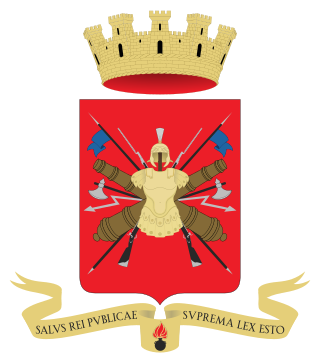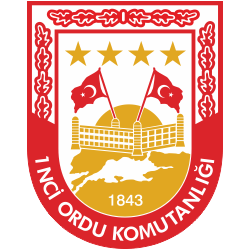
The 9th Infantry Division is an inactive infantry division of the United States Army. It was formed as the 9th Division during World War I, but never deployed overseas. In later years it was an important unit of the U.S. Army during World War II and the Vietnam War. It was also activated as a peacetime readiness unit from 1947 to 1962 at Fort Dix, New Jersey, and Fort Carson, Colorado, and from 1972 to 1991 as an active-duty infantry division at Fort Lewis, Washington. The division was inactivated in December 1991.

The Italian Army is the land force branch of the Italian Armed Forces. The army's history dates back to the Italian unification in the 1850s and 1860s. The army fought in colonial engagements in China, Libya, Northern Italy against the Austro-Hungarian Empire during World War I, Abyssinia before World War II and in World War II in Albania, Balkans, North Africa, the Soviet Union, and Italy itself. During the Cold War, the army prepared itself to defend against a Warsaw Pact invasion from the east. Since the end of the Cold War, the army has seen extensive peacekeeping service and combat in Afghanistan and Iraq. Its best-known combat vehicles are the Dardo infantry fighting vehicle, the Centauro tank destroyer and the Ariete tank and among its aircraft the Mangusta attack helicopter, recently deployed in UN missions. The headquarters of the Army General Staff are located in Rome opposite the Quirinal Palace, where the president of Italy resides. The army is an all-volunteer force of active-duty personnel.

The First Army of the Republic of Turkey is one of the four field armies of the Turkish Army. Its headquarters is located at Selimiye Barracks in Istanbul. It guards the sensitive borders of Turkey with Greece and Bulgaria, including the straits Bosporus and Dardanelles. The First Army is stationed in East Thrace.

The Turkish Land Forces, or Turkish Army, is the main branch of the Turkish Armed Forces responsible for land-based military operations. The army was formed on November 8, 1920, after the collapse of the Ottoman Empire. Significant campaigns since the foundation of the army include suppression of rebellions in Southeast Anatolia and East Anatolia from the 1920s to the present day, combat in the Korean War, the 1974 Turkish invasion of Cyprus and the current Turkish involvement in the Syrian Civil War, as well as its NATO alliance against the USSR during the Cold War. The army holds the preeminent place within the armed forces. It is customary for the Chief of the General Staff of the Turkish Armed Forces to have been the Commander of the Turkish Land Forces prior to his appointment as Turkey's senior ranking officer.

The Turkish Third Army is a field army of the Turkish Army and is the country's largest army.

The Syrian Army, officially the Syrian Arab Army, is the land force branch of the Syrian Armed Forces. It is the dominant military service of the four uniformed services, controlling the most senior posts in the armed forces, and has the greatest manpower, approximately 80 percent of the combined services. The Syrian Army originated in local military forces formed by the French after World War I, after France obtained a mandate over the region. It officially came into being in 1945, before Syria obtained full independence the following year.

The 79th Group Army, Unit 31671, formerly the 39th Group Army, is a military formation of the Chinese People's Liberation Army Ground Forces (PLAGF). The 79th Group Army is one of thirteen total group armies of the PLAGF, the largest echelon of ground forces in the People's Republic of China, and one of three assigned to the nation's Northern Theater Command.
The 70th Mechanized Infantry Brigade is a brigade of the Turkish Army based in the Southeastern Anatolia Region at the town of Kızıltepe in Mardin Province. It is part of the Army's 7th Corps based at Diyarbakir.
This is an order of battle of the Chilean Army.
This is the order of battle of the Turkish Army in June 1941. The formation named 941-A Seferî Kuruluş was as follows:

This is the order of battle for the Liberation of Kuwait campaign during the Gulf War between Coalition forces and the Iraqi Armed Forces between February 24–28, 1991. The order that they are listed in are from west to east. Iraqi units that were not in the Kuwaiti Theater of Operations are excluded from this list. Some Iraqi divisions remained un-identified by Department of Defense intelligence and a number of the details of the Iraqi order of battle are in dispute among various authoritative sources.

This is the order of battle for the invasion of Iraq during the Iraq War between coalition forces and the Iraqi Armed Forces; Fedayeen Saddam irregulars; and others between March 19 and May 1, 2003.

The 2nd Corps is a field corps of the Turkish Army. It is headquartered at Gelibolu in Çanakkale Province. In 2013 it appeared to be under command of Major General Mustafa Oğuz.

The 7th Corps is a field corps of the Turkish Land Forces. Its headquarters is in Yenişehir, Diyarbakır. The 2nd Army affiliated to the Turkish Land Forces. Turkey provinces; It protects Hakkâri, Şırnak, Şanlıurfa and Siirt against foreign threats that may come from abroad.

The 1st Corps is a corps of the Syrian Army that was first formed in 1985. Richard Bennett wrote in 2001 that "three corps [were] formed in 1985 to give the Army more flexibility and to improve combat efficiency by decentralising the command structure, absorbing at least some of the lessons learned during the 1982 Lebanon War." He said that the 1st Corps covered southern Syria, in particular the heavily fortified defense zone between Damascus and the Golan Heights and south to Daraa near the border with Jordan. On 29 December 2022, Major General Suhail Asaad was appointed as commander of the 1st Army Corps of the Syrian Arab Army.
The 190th Heavy Combined Arms Brigade is a military formation of the People's Liberation Army of the People's Republic of China. It is famous for being the first mechanized PLA division.

On October 8, 1950, 3rd Tank Division(Chinese: 战车第3师) was formed in Siping, Jilin province from 1st Independent Division, Northwestern Military Region.

The 2nd Heavy Combined Arms Brigade, originally the 2nd Tank Division, the 2nd Armored Division and the 2nd Armored Brigade, is an armored formation of the People's Liberation Army Ground Force of the People's Republic of China.















